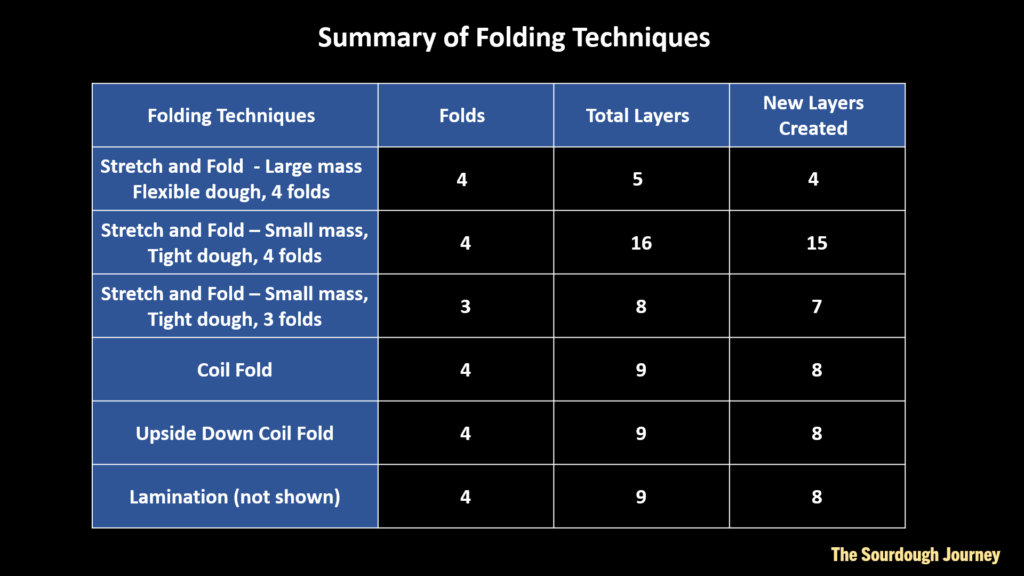Bulk Fermentation - Handling
Frequently Asked Questions
The way you handle your dough in bulk fermentation can materially impact the outcome of your sourdough loaves. The typical methods of handling the dough in bulk fermentation include:
- No handling (true “no knead”)
- Stretch and Folds
- Coil Folds
- Lamination
No Handling – It is possible to make sourdough bread with no handling of the dough at all during bulk fermentation. These methods typically require more gluten development during the mixing process. You will often see recipes call for 10-15 minutes of hand mixing and/or techniques such as “slap and fold” or the Rubaud method of mixing in such recipes.
Stretch and Folds – The “Stretch and Fold” method was popularized in Chad Robertson’s “Tartine Bread” method. See videos below for a demonstration. When doing stretch and folds, most recipes call for 4-6 rounds with 30-minute rests in between each round. Early stretch and folds can be more aggressive. Later stretch and folds should be gentler.
Coil Folds – Coil folds are a popular method of dough handling. This method was popularized in the video “How to Make a Basic Open Crumb Sourdough Bread” from Full Proof Baking. Coil folds are a more gentle handling method and they create more layers in the dough than the stretch and fold methods. These methods are compared in the video below.
Lamination – Lamination is a somewhat specialized handling technique in bulk fermentation and is usually only done once, and in combination with the methods described above. The Full Proof Baking video uses a combination of coil folds and lamination. The benefit of lamination is a more aggressive stretch than coil folding, and lamination creates a lot of structure in the dough with the many folds on all angles.
Lamination is also a preferred technique for incorporated add-ins (e.g., nuts, cranberries, cheese) during bulk fermentation.
Why different methods – All of the handling methods are essentially achieving a similar goal — building gluten structure and creating layers in the dough. The techniques are related to the steps prior to bulk fermentation (e.g., mixing methods) and the steps after bulk fermentation (e.g., pre-shaping and final shaping). It is important to understand the entire “Gluten Structure Chain” to fully understand the role of dough handling in bulk fermentation.
Most recipes call for 4-6 sets of stretch and folds with 30-minute rests. I always do at least 4 sets. After the fourth set, I assess how the dough feels. If it is holding is shape well and feels silky and supple, I assess if it needs more handling. There is a trad- off between more handling and letting the dough rise untouched later in bulk fermentation. I prefer at least 2 hours of untouched dough at the end of bulk fermentation.
Most recipes recommend 4 or 6 sets of stretch and folds with 30 minutes intervals. Also, you do not want to be handling the dough late in the bulk fermentation process. It is best to leave it untouched for the last 2 hours (minimum) of bulk fermentation.
They are two different methods of building dough strength and creating layers in the dough during bulk fermentation. Stretch and folds are a more aggressive handling of the dough and focus more on the stretch and less on the fold. The process creates 4 new layers in the dough with each set. Coil folding is a more gentle method of handling the dough and focuses more on the fold than the stretch. Each coil fold creates 8 new layers in the dough. Some approaches use both with stretch and folds usually being done earlier in the bulk fermentation process and coil folds being done later.
Most recipes recommend combining add-ins after the second stretch and fold process. You can mix them in by hand or you can laminate them. Here is a guide showing how to evenly laminate your add-ins into your dough.
The type of handling technique used in bulk fermentation can impact the number of layers created in the dough. This builds dough structure and height, so it is important to know the difference between the methods.
This chart is excerpted from the video, “Tartine Bread: The Art and Alchemy.” The video clip is in the section below. 
Yes! The timing of the folds is critically important.
First, you always want to let the dough rest between folds. The most typical rest time is 30 minutes between folds. This lets the gluten relax and the next fold is more effective.
Second, you want to do most of the handling early in the bulk fermentation process and leave the dough untouched at the end of bulk fermentation.
Some additional rules of thumb for dough handling timing.
- Stretch and folds can be more aggressive on the first few rounds and should be more gentle as they progress. For example, if you are doing 5 sets of stretch and folds, get a good stretch on the first 3, then a much more gentle stretch on the last two. Just stretch it enough to be able to fold it over.
- Coil folds are a more gentle handling technique in general and if you are combing stretch and folds and coil folds, do the stretch and folds first, and the coil folds later. For example, in 5 rounds of folds, many bakers do 3 stretch and folds followed by two coil folds.
- Lamination should generally be done early in the process versus later because it really stretches and compresses the dough. Lamination is often mixed in with the other folding techniques. For example, if doing 5 sets of folds, a common approach is to do 2 sets of stretch and folds, one lamination, and two coil folds — in that order. Typically, with 30-minute breaks between each set of folds.
I demonstrate and discuss all of these techniques in the video series, “Tartine Bread: The Art and Alchemy.”
- Create gluten – you do this by adding flour and water. It is a chemical reaction.
- Strengthen gluten – this is done by handling the dough such as hand mixing, Rubaud method, slap and fold method and stretch and fold (as a last resort if you haven’t done any of the prior).
- Build Gluten Layers – this is done by folding the dough on top of itself. It creates height in the gluten matrix — stretch and folds, coil folds and lamination are most common.
videos
Video Clip: Demonstration of Dough Handing Techniques
In this video clip, I discuss and demonstrate the four most popular handling methods, 1) no handling, 2) stretch and fold, 3) coil fold, and 4) lamination.
The different handling methods create different layering in the dough, as discussed here.
This video is a clip from the longer video, “The Impact of Bulk Fermentation on Open Crumb.”
Video Clip: Dough Handling Techniques
In this video clip, I more advanced considerations in dough handling techniques such as stretch and fold and coil folds. Also I introduce the “Upside down coil fold.”
This video is a clip from the longer video, “Tartine Bread: The Art and Alchemy.”
Video Series: The Impact of Bulk Fermentation on Open Crumb
In this video series, I bake 5 loaves using different bulk fermentation handling techniques and demonstrate the impact on the crumb. The findings are fascinating.
Video Series: Tartine Bread: The Art and Alchemy
In this video series, I bake multiple loaves using different handling techniques. This is the most detailed video content on this topic you will find anywhere.
Full Proof Baking: How to Make an Open Crumb Sourdough Loaf
Kristen Dennis’ seminal video is one of the most popular sourdough videos of all time. Kristen’s dough handling is impeccable and her combination of lamination and coil folding has been adopted as the “open crumb” standard approach by many bakers.
Additional resources
Coming Soon…
